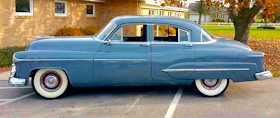The Wikipedia entry for the Grand Prix is here. I question its early generational definitions, but will let that pass for now. Below are profile views of cars from each redesign generation with the exception of 1963 where that fabulous facelifted Grand Prix emerged.
What happened was fairly typical of American automobile marketing. A new top-of-the-range model is introduced, then later on a new line-topper replaces it and the former leader's name is preserved, but dropped down a notch. Then perhaps it might drop to another level even later. There are exceptions such as Ford's Mustang and the Chevrolet Camero. But the Grand Prix, though it mostly remained a coupe, became less glamorous within Pontiac's model list. It did stay near the top if Pontiac's price range, but was usurped by the Parisienne in 1983, and by Bonneville in 1987 and later.
Unless noted, photos below are of cars listed for sale.
1962 Pontiac Grand Prix - Mecum Auction photo
The original Grand Prix, based on Pontiac's 1961 redesign.
1963 Pontiac Grand Prix
The classic Pontiac Grand Prix design.
1965 Pontiac Grand Prix - Mecum
A redesign that's more bloated. The concave backlight window and C-pillar profile feature is retained.
1969 Pontiac Grand Prix
Starting here, the classic Grand Prix elements disappear.
1973 Pontiac Grand Prix
Now for the Opera Window fad.
1978 Pontiac Grand Prix
This Grand Prix is fairly small, its wheelbase of 108.0 inches (2743 mm) is down from the previous design's 116.0 inches (2946 mm). The classic Grand Prix's wheelbase was 120.0 inches (3048 mm).
1988 Pontiac Grand Prix
This Grand Prix's wheelbase was similarly short.
1997 Pontiac Grand Prix
Some '97 Grand Prix's were four-door sedans, along with the coupe model shown here.
2004 Pontiac Grand Prix - factory image
All 2004 generation Grand Prix's were sedans. Not a bad looking car when viewed from other anlges, but with no trace of the classic design.





















































